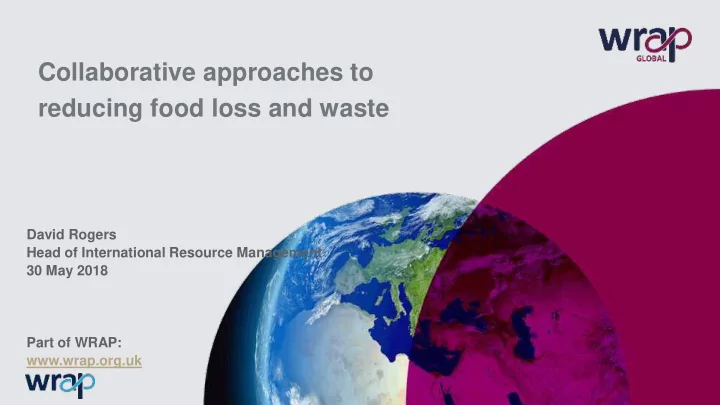

Collaborative approaches to reducing food loss and waste David Rogers Head of International Resource Management 30 May 2018 Part of WRAP: www.wrap.org.uk
WRAP’s vision is a world in which resources are used sustainably
A Collaborative Approach collaborate collaborated; collaborating intransitive verb 1 : to work jointly with others or together especially in an intellectual endeavour. 2 : to cooperate with or willingly assist an enemy of one's country and especially an occupying force suspected of collaborating with the enemy 3 : to cooperate with an agency or organisation with which one is not immediately connected.
Collaborative Agreements Framework | Roadmap | Voluntary Agreement | Pact “A collaboratively agreed, self - determined ‘pact’ to take action on [ food waste generated at relevant stages of the food system ].”
Benefits of Collaborative Approaches OECD: • faster to implement and to adapt to new circumstances; • can be better designed than legislation, since they are normally produced by those with an in-depth knowledge of the business sector in question; • encouraging constant improvement and innovation (whereas legislation generally sets a target, but does not encourage further improvement); and • allowing parties to the agreement greater choice over how to achieve the overall objective than legislation, which tends to be more prescriptive Voluntary Approaches for Environmental Policy, An Assessment, OECD, 11 Jan 2000, ISBN 978926418026
Benefits of Collaboration 7 7 7 7 7 6 6 6 5 5 4 4 3 3 3 3 2 2 2 2 2 1 1 1 1 1 Germany Hungary Spain The Netherlands
WRAP’s Collaborative Agreements
Courtauld Commitment track record Courtauld 1 (2005-2009): • 1.2 million tonnes of food and packaging waste were prevented. • 670,000 tonnes of food waste and 520,000 tonnes of packaging were avoided across the UK between 2005 and 2009. Courtauld 2 (2009-2012): • A total of 1.7 million tonnes of waste prevented, saving £3.1 billion. This represents a reduction of 4.8 million tonnes of CO2eq. Courtauld 3 (2012-015): • Over £100 million business savings delivered by reducing food waste. • 7% reduction in carbon impact of food and drink packaging . • A notable increase in surplus food and drink redistributed for human consumption.
Courtauld 2025
C2025 Signatories
Collaborating to Tackle Supply Chain Waste
Supply Chain 22/06/2018 www.eu-refresh.org
Supply Chain 22/06/2018 www.eu-refresh.org
Supply Chain 22/06/2018 www.eu-refresh.org
Collaborating to Reach Consumers
Collaborating to Reach Consumers: Retailers and brands
Example of recent retailer activity WRAP’s
Collaborating to Reach Consumers: Local authorities
Collaborating to Reach Consumers: Community orgs
Section 3 Successful Collaborations
Success Factors of Collaborative Agreements Monitoring Initiation and Governance Establishing Ambition and set up and funding actions evaluation 22/06/2018 www.eu-refresh.org
Key Success Factors Strong lead organisation and right mix of key players Effective Governmental measuring and involvement at reporting early stage framework Engage Availability of signatories in funding aids the early 22/06/2018 www.eu-refresh.org effectiveness stages
Blueprint For Collaborations & Frameworks MONITORING INITIATION & EVALUATION & SET-UP ACTIONS AMBITION GOVERNANCE & FUNDING
Initiation & set-up Use to identify key players Can you identify a trusted and neutral lead INITIATION organisation? & SET-UP Do you have government support? What are your priority areas? 22/06/2018 www.eu-refresh.org
Ambition Use to identify targets, timeframe and areas of focus Is there a national target, e.g. “Reduce waste by AMBITION X% by Y date”? Are you aligned with wider goals such as UN SDG12.3 22/06/2018 www.eu-refresh.org
Measurement of food waste
Why measure? Understand: The issue What works to prevent food waste Monitor targets For decision making For communications For making the business case
Retail: what do we do in the UK? With the CC, retailers monitor and report their FLW to WRAP CC has retailers accounting for c. 90% of the UK market At least two methods used including: Waste management data plus waste compositional analysis Scanning items that become loss / waste – report generated electronically Definition of FLW and boundaries agreed with CC signatories Ensuring definitions and boundaries are used in practice is an on- going challenge
Wholesale and distribution Courtauld signatories report on FLW where they own the food. Therefore much of distribution (including Regional Distribution Centres) is reported by retailers. Manufacturers report on waste when they still own the products. Previous studies have shown that waste from wholesale in the UK is a relatively small amount, so – although an estimate exists (40,000 tonnes) – it is not regularly tracked.
Manufacturing: National estimate UK estimate based on three datasets: Reporting to the UK Environment Agency as part of Integrated Pollution Prevention Control (IPPC) legislation Provides information on the amount of waste for a business of a given sector and size, split by European Waste Catalogue (EWC) codes (annual data) WRAP commissioned compositional analysis to understand the % of food waste in different waste streams (categorised by type and size of business and EWC code) – ideal project would cost £millions Information on number of business, by sector and size (annual data)
Household: what do we do in the UK? In 2007 and 2012, we obtained detailed information: Synthesis of local authority data: LA collected waste: residual, collections targeting food waste Detailed waste compositional analysis (WCA): Types of food, state, other info for LA collected waste Kitchen diaries: Amounts for home composted, sewer, reasons for disposal In many intervening years (2010, 2014, 2015), we have just performed the synthesis of local authority data , and modelled waste to sewer and home composting.
Useful results http://www.wrap.org.uk/content/household-food-and-drink-waste-uk-2012
Diary – example statistics for bread http://www.wrap.org.uk/sites/files/wrap/Product-focused%20report%20v5_3.pdf
Campaigns can require facts…
Monitoring targets http://www.wrap.org.uk/content/household-food-waste-uk-2015-0
The Business Case Joint World Resources Institute / WRAP study Measurement in the supply chain crucial to the business case http://www.wrap.org.uk/co ntent/business-case- reducing-food-loss-and- waste-0
Contact us WRAP GLOBAL Second Floor Blenheim Court 19 George Street Banbury, OX16 5BH UK Telephone: +44 (0)1295 819900 wrapglobal.org
Recommend
More recommend